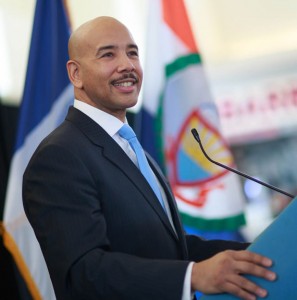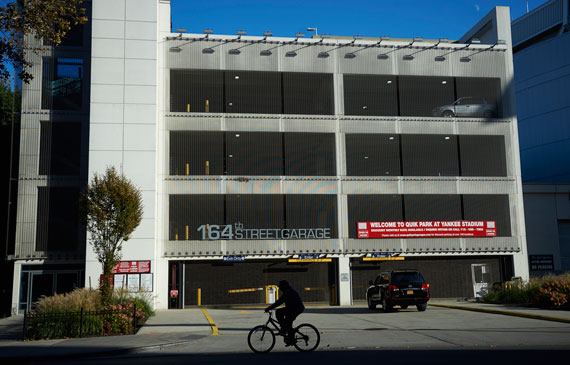 When Fresh Direct announced it would relocate its Long Island City warehouse to the Bronx in 2012, tabloid headlines had a field day, declaring that New York defeated New Jersey in a hard-fought “food fight.”
When Fresh Direct announced it would relocate its Long Island City warehouse to the Bronx in 2012, tabloid headlines had a field day, declaring that New York defeated New Jersey in a hard-fought “food fight.”
As it turned out, New York offered Fresh Direct a sweeter deal that included $130 million in grants, tax breaks and tax credits to build a new 500,000-square-foot distribution center, compared with the Garden State’s best offer of roughly $100 million.
With 1,000 new jobs and the promise of future tax revenue on the line, New York’s package reflected a coordinated assault by state, city and local governments.
Fresh Direct is now building its facility on a 16-acre parcel on Bruckner Boulevard between the Third Avenue and Willis Avenue bridges.
“We’re investing because we need businesses to get bigger, smarter and employ our residents,” said Marlene Cintron, president of the South Bronx Overall Economic Development Corporation, one of a slew of entities involved in the Fresh Direct deal.
That resolve is at the heart of the push by local lawmakers looking to entice business owners — and developers — to invest in the Bronx.
And the public financial incentives being offered are the bait helping to convince developers to shell out their own investment dollars in a borough that until recently has not seen much interest from real estate investors.
Developer Robert Frost, co-founder of Signature Urban Properties, said Mayor Bill de Blasio’s administration has been a “tremendous partner” in providing financing for his firm’s 10-building residential complex in Crotona Park East. The project, which also received state funding, is set to have 1,300 units of affordable housing.
Accelerating development
The political push seems to be working.
From rezonings to infrastructure projects and financial incentives, stakeholders have knit together programs that helped to generate more than $1.1 billion in residential, institutional and commercial development in 2014, a 26 percent jump from the prior year, according to a report from Bronx Borough President Ruben Diaz Jr.’s office.

Bronx Borough President Ruben Diaz Jr.
And Diaz, who was elected at age 24 to the New York State Assembly, has been at the center of the efforts to spur development since taking office in 2009.
Now 42, Diaz wields considerable power in the real estate world. Not only does his office have a representative on the City Planning Commission, he’s cultivated powerful allies among developers and has a vested interest in seeing their investments succeed.
“We have the land and space available for people to develop,” said Diaz, who is often mentioned as a potential mayoral candidate. “My job is to get people to come here to look at the borough in a new light.”
Nearly every developer interviewed by The Real Deal credited Diaz with working to accelerate development, whether by lobbying for infrastructure upgrades or pushing through rezonings.
According to Ariel Property Advisors’ Victor Sozio, an active commercial broker in the Bronx, strong political leadership and developer confidence is fueling the current investment boom.
“You have a borough, being led by Ruben Diaz, that’s also investing in real infrastructure,” he said.
Last month, Diaz and transit advocates also scored a huge win when city and state officials agreed to fund the Metropolitan Transit Authority’s $29 billion capital plan, which includes a major infrastructure upgrade in the Bronx to expand Metro-North Railroad service.
The $1 billion project will add train stations in Co-op City, Hunts Point, Morris Park and Parkchester. It’s projected to add 5,400 local jobs and to raise residential property values by as much as $142,000, according to a study commissioned by Diaz and state Sen. Jeff Klein.
Those statistics, of course, will come in handy when selling the Bronx to developers going forward. Talking about residential development without also discussing transportation improvements doesn’t make sense, Diaz said.
“It is, by far, one of the most essential ways to drive the economy of this city,” he said of good transit.
In addition to the sweeping policies that Diaz believes will improve the Bronx economy, the borough president has rallied behind individual projects.
For example, he’s lobbying to find a better use for a parking garage next to Yankee Stadium that often sits empty.
“That lot is 60 percent vacant on game night,” Diaz said. “I think it could serve as another anchor, a world-class hotel or conference center where we can create jobs.” While he’s been wooing potential developers to seize the opportunity, he hasn’t yet landed any takers.
In recent years, the city has also been a willing partner.
In February, de Blasio committed $200 million toward investment in the Lower Grand Concourse area — a 30-block stretch of the Bronx’s main thoroughfare that touches the waterfront but is home to auto shops and waste-transfer stations.
The funds are earmarked for environmental remediation as well as for the development of 4,000 units of affordable housing.

164th Street garage
Recent efforts to revitalize the borough started when Mayor Michael Bloomberg was in City Hall.
The city rezoned 29 areas in the Bronx between 2003 and 2013, including East Fordham Road, Third Avenue and Hunts Point, according to the Department of City Planning’s website. The city is now studying whether to allow more residential development on several other corridors — including Jerome Avenue, the Sheridan Expressway and surrounding area, and others. If approved theses rezonings will open up more areas of potential for developers.
Cushman & Wakefield’s Dave Simone is currently marketing a 21,000-square-foot property at 1491 Jerome Avenue.
“We’re getting a lot of interest from residential developers,” he said. “Even though it’s somewhat of a gamble, people are counting on the city to rezone the area.”
Diaz said his office works closely with stakeholders to identify which neighborhoods prospective investors are interested in.
“They know they can build something without worrying about that uncertainty of whether the zoning will come into play,” he said.
Political clout
Signature Urban Properties was started in 2007 by Frost and Gifford Miller, the former speaker of the City Council and a one-time mayoral candidate whose political savvy and connections are undoubtedly an asset in the world of Bronx development.
After assembling a site along the Sheridan Expressway, Signature petitioned the city to rezone a 16.8-acre area in the Crotona Park East and West Farms neighborhoods.
“It was really an abandoned industrial area with no economic vitality,” said Frost. “The city was very receptive, as was the community.”
The firm received more than $16 million from the city’s Department of Housing and Preservation Development, plus $1.2 million from Diaz’s office and $1.3 million from City Council Member Joel Rivera.
“We’re not trying to change the Bronx into Brooklyn or into something it isn’t; these are buildings that will largely be populated by people who live in the Bronx,” Frost said.
Similarly, SBOEDC’s Cintron wants to help Bronx businesses to become land owners (not renters).
“We don’t want to lose the businesses to speculators who will purchase property and knock the [businesses] out,” she said.
SBOEDC is currently working with a local business owner to buy a city-owned warehouse in Port Morris. After the master leaseholder let the building fall into disrepair, Cintron said the business owner, who restores art for major art institutions like the Met, considered moving. “I said to the city, ‘I’m not going to lose a business. Sell this building,'” she said. At press time, the warehouse was set to be sold for a minimum bid of $11 million.